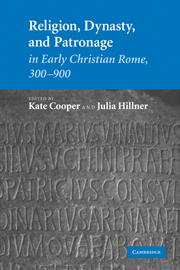Book contents
- Frontmatter
- Contents
- Acknowledgements
- List of contributors
- Abbreviations
- Introduction
- PART I ICONS OF AUTHORITY: POPE AND EMPEROR
- 1 From emperor to pope? Ceremonial, space, and authority at Rome from Constantine to Gregory the Great
- 2 Memory and authority in sixth-century Rome: the Liber Pontificalis and the Collectio Avellana
- PART II LAY, CLERICAL, AND ASCETIC CONTEXTS FOR THE ROMAN GESTA MARTYRUM
- PART III RELIGION, DYNASTY, AND PATRONAGE
- Bibliography
- Index
2 - Memory and authority in sixth-century Rome: the Liber Pontificalis and the Collectio Avellana
Published online by Cambridge University Press: 02 October 2009
- Frontmatter
- Contents
- Acknowledgements
- List of contributors
- Abbreviations
- Introduction
- PART I ICONS OF AUTHORITY: POPE AND EMPEROR
- 1 From emperor to pope? Ceremonial, space, and authority at Rome from Constantine to Gregory the Great
- 2 Memory and authority in sixth-century Rome: the Liber Pontificalis and the Collectio Avellana
- PART II LAY, CLERICAL, AND ASCETIC CONTEXTS FOR THE ROMAN GESTA MARTYRUM
- PART III RELIGION, DYNASTY, AND PATRONAGE
- Bibliography
- Index
Summary
Then Damasus sent in the gladiators, the charioteers, the gravediggers, and all the clergy armed to the teeth with swords and clubs to besiege the basilica. And they joined battle in earnest … From all sides the Damasans broke into the basilica and killed a hundred and sixty people, women as well as men. They wounded several more, many of whom were to die later. On the Damasan side, there was not one casualty.
Historians of late Roman Christianity, especially those of a Gibbonian stripe, take delight from this extraordinary account of the no-holds-barred contest for the papacy in 366, and the resulting massacre in the Liberian basilica of the supporters of Ursinus. But they rarely take heed of their source. The text stands at the opening of the Collectio Avellana, a mid-sixth-century collection of nearly 250 documents relating to the bishopric of Rome in the fourth, fifth, and sixth centuries. While its account of Damasus is frequently cited, the Collectio as a whole is something of a backwater, in both medieval and modern scholarship. This obscurity is surely undeserved, and it obtains only because we have asked the wrong question. As an early medieval canon law collection the Collectio is indeed a virtual dead end – far less successful and important than the near-contemporary collection of Dionysius Exiguus.
- Type
- Chapter
- Information
- Publisher: Cambridge University PressPrint publication year: 2007
- 5
- Cited by



